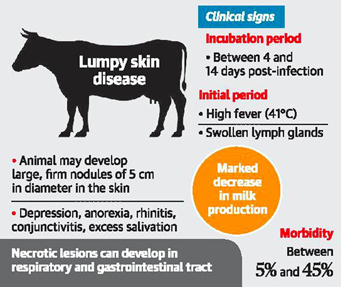

21st September 2022 (7 Topics)
Context
The Mumbai Police have ordered the prohibition of cattle transportation in the city to prevent the spread of the lumpy skin disease.
- The viral infection has killed nearly 75,000 cattle in India and spread to more than 10 States and UTs, hitting Rajasthan the worst.
About
Lumpy Skin Disease
- Lumpy skin disease is caused by the lumpy skin disease virus (LSDV), which belongs to the genus capripox virus, a part of the poxviridae family (smallpox and monkeypox viruses are also a part of the same family).
- The LSDV shares antigenic similarities with the sheeppox virus (SPPV) and the goatpox virus (GTPV) or is similar in the immune response to those viruses.
- It is not a zoonotic virus, meaning the disease cannot spread to humans.
- It is a contagious vector-borne disease spread by vectors like mosquitoes, some biting flies, and ticks and usually affects host animals like cows and water buffaloes.
- Symptoms:
- LSD affects the lymph nodes of the infected animal, causing the nodes to enlarge and appear like lumps on the skin, which is where it derives its name from.
- The cutaneous nodules, 2–5 cm in diameter, appear on the infected cattle’s head, neck, limbs, udder, genitalia, and perineum.
- The nodules may later turn into ulcers and eventually develop scabs over the skin.
- The other symptoms include high fever, sharp drop in milk yield, discharge from the eyes and nose, salivation, loss of appetite, depression, damaged hides, emaciation (thinness or weakness) of animals, infertility and abortions.
- Morbidity: The morbidity of the disease varies between two to 45% and mortality or rate of death is less than 10%, however, the reported mortality of the current outbreak in India is up to 15%, particularly in cases being reported in the western part (Rajasthan) of the country.

- Geographical Distribution:
- LSD is endemic to Africa and parts of West Asia, where it was first discovered in 1929.
- In Southeast Asia the first case of LSD was reported in Bangladesh in July 2019.
- In India it was first reported from Mayurbhanj, Odisha in August 2019.
Impact on economy
The infectious nature of LSD and its implications cause significant economic losses to farmers. Major reasons for the loss are as given below:
- decreased milk production
- abortions and infertility
- damaged hides due to cutaneous nodules and fibrous tissue growth
Is it safe to consume the milk of affected cattle?
- Studies say that it has not been possible to ascertain the presence of viable and infectious LSDV virus in milk derived from the infected animal.
- However, FAO notes that a large portion of the milk in Asia is processed after collection and is either pasteurised or boiled or dried in order to make milk powder. This process ensures that the virus is inactivated or destroyed.
How bad is the current spread in India?
- The current outbreak started in Gujarat and Rajashthan around July and had spread to Punjab, Himachal Pradesh, Andaman & Nicobar and Uttarakhand by early August.
- It then spread to Jammu and Kashmir, Uttar Pradesh and Haryana.
- In recent weeks, it was reported in Maharashtra, Madhya Pradesh, Delhi, and Jharkhand.
- The virus has infected over 16 lakh cattle in 197 districts as of September 11.
- Of the nearly 75,000 cattle that the disease has killed, more than 50,000 deaths, mostly cows, have been reported from Rajasthan.
Food and Agriculture Organization (FAO) Suggestions:
The FAO has suggested a set of spread-control measures for LSD, which involves
- vaccination of susceptible populations with more than 80% coverage,
- movement control of bovine animals and quarantining,
- implementing biosecurity through vector control by sanitising sheds and spraying insecticides,
- strengthening active and passive surveillance;
- spreading awareness on risk mitigation among all stakeholders involved, and
- creating large protection and surveillance zones and vaccination zones
Measures taken by India:
- The ‘Goat Pox Vaccine’ is “very effective” against LSD and is being used across affected States to contain the spread.
- As of the first week of September, 97 lakh doses of vaccination have been administered.
- The affected States have put movement bans in place and are isolating infected cattle and buffaloes, spraying insecticides to kill vectors like mosquitoes.
- Some affected States such as Maharashtra, Rajasthan, Delhi, and Uttar Pradesh also setting up dedicated control rooms and helpline numbers to guide farmers whose cattle have been infected.
- In a major breakthrough, two institutes of the Indian Council of Agricultural Research (ICAR) have developed an indigenous vaccine for LSD, which the Centre plans to commercialise and roll out in the next three to four months.


